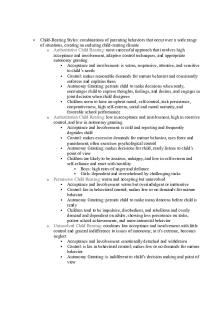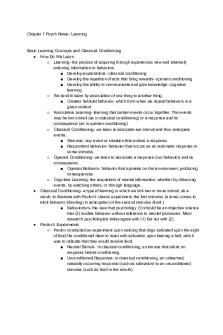Summary Clinical Psychology - Chapter 4,15,17 PDF

| Title | Summary Clinical Psychology - Chapter 4,15,17 |
|---|---|
| Author | Subbi Madhavan |
| Course | Abnormal Psychology |
| Institution | University of Texas at Austin |
| Pages | 6 |
| File Size | 150 KB |
| File Type | |
| Total Downloads | 136 |
| Total Views | 746 |
Summary
Chapter Methods in Clinical Psychology Introduction As simple and traditional explanation for clinical problems are so often incorrect, sophisticated methods have been developed to provide explanations for behavior. All ideas and hypothesis must be stated clearly and precisely so they can be tested ...
Description
Chapter 4—Research Methods in Clinical Psychology Introduction
As simple and traditional explanation for clinical problems are so often incorrect, sophisticated methods have been developed to provide explanations for behavior. All ideas and hypothesis must be stated clearly and precisely so they can be tested by others. Research allows us to abandon speculation and appeal to authority (demonstration). Research allows us to extend and modify theories & establish parsimony and utility. Theories stimulate and guide research but theories are also modified based on outcomes of research. o Beck’s congruency theory—interaction between personality type (sociotropic—very socially dependent) or autonomous (very achievement oriented) and experience of negative life events depression. o Negative life events must be congruent with personality for depression to develop. Research ultimately allows us to predict and understand behavior, thoughts and feelings.
Methods: Observation
Unsystematic Observation: Casual observation is not very helpful and can lead to forming wrong conclusions; but it can help us form hypothesis to test. Naturalistic Observation: o Most systematic and rigorous than unsystematic observation as it is carefully planned in advance. o There is no control and observers are limited to only a few situations or individuals, so it may be hard to generalize. o Observer may accidentally interrupt or influence the participants “alter their behavior in the presence of the observer”. o Critics sometimes view naturalistic observation as being too uncontrolled; but these are useful because hypothesis are not tested in an artificial experimental setting. Controlled Observation: o Researcher has some level of control over events; this provides richer results. o Can be used to assess communication patterns among couples or spouses under controlled settings. Case Studies: o Intensive study of a client or patient that is in treatment. Includes intensive description of a client. Additional material like letters, diaries, biographical info may be included. o Very useful generating hypothesis, for providing descriptions of rare phenomena, for interview assessments & for disconfirming universally accepted information. o Case studies can’t be used to develop laws that can be applied to everyone, can’t develop cause-effect conclusions as researchers are unable to control all variables.
Epidemiological Methods
Epidemiology: Study of incidence, prevalence and distribution of illness in a given population. Incidence: Number of new cases that develop within a given time period in a population. Allows us to know if a disease/disorder is on the rise.
Prevalence: Total number of cases within a population (old + new cases). Allows us to know what % of the population is impacted. Used most commonly with medical research to assess and control epidemic diseases, can also be used to identify individuals that may be at high risk. Smoking & Health study—linked cigarette smoking with lung cancer (obtained correlations may suggest causes but can’t prove them). Epidemiological research is largely based on surveys & interviews but these methods can cause problems. o Checking specific regions (e.g. hospitals, clinics) eliminate other regions and so collecting data block by block or region by region is important. o Respondent’s may want to “say the right thing” and so don’t report true data. Clients should be assessed at the time of interest instead of using retrospective data. Women are at greater risk for developing anxiety and mood disorders and men are at greater risk for substance use and impulse control disorders.
Correlational Methods: The Technique
Looks at whether variable X is related to variable Y. Obtain 2 sets of observations, and when the data are correlated correlation coefficient. Pearson’s correlation coefficient is the most commonly used index to determine the relationship between 2 variables. Denoted by r (+1.00 is a strong positive relationship; -1.00 is a strong negative relationship). Scatterplot: Graph of data points, where each point represents a participants score. More perfect a relationship, the straighter the line will be. When r is close to zero (no relationship) the points are scattered in a random manner on the graph.
Correlational Methods: The Question of Causality
Correlation can’t be used to state that one variable causes the other (INCORECT!) Third-Variable Problem: Possibility that correlation between variable A and B is due to the influence of an unknown third variable rather than a causal relationship between A and B. Correlation can show that cause-effect relationship is not valid, two variables can be correlated but one does not necessarily cause the other. Causal relationships must be demonstrated through experimental testing.
Correlational Methods: Factor Analysis
A method of examining the interrelationship among a number of variables at the same time. When variables change together there must be an underlying element in common. After tests are correlated a correlation matrix is generated that gives us correlations between all pairs of tests. Allows us to determine if certain patterns measure similar underlying dimensions or factors.
Cross-Sectional Versus Longitudinal Approaches
Cross-Sectional Design: Compares different groups of individuals at one point in time (ex: different age groups). These are correlational because the researcher can’t manipulate age and can’t assign participants to different groups. Longitudinal Design: Follows the same subjects over a period of time. o Allows us to assess how a variable change over time with age (better understand timeorder relationships). o Also help reduce third-variable problem. These studies are very expensive and need a lot of patience, participants may also drop out.
The Experimental Method
To determine cause-effect relationships experimental methods must be used. Experimental group: Group that obtains the treatment of interest. Control group: Group that does not obtain treatment of interest. Experimental and control groups are supposed to be similar on all variables with the exception of the treatment variable. Assignment to experimental or control group is typically done through random assignment. Experimental Hypothesis: Theory on which experimental study is based. Hypothesis predicts the effects of the treatment given. Independent Variable: The variable that is manipulated Dependent Variable: The variable that is measured A good design matches subjects on important variables (ex: age, gender, levels of depression).
The Experimental Method: Between and Within Group Designs
Between-Groups Design: Two sets of participants, each of which receive a different type of treatment or intervention. Within-Group Design: Comparisons are made on the same patient at different points in time. This requires fewer participants.
The Experimental Method: Internal Validity
An experiment is internally valid if change in the dependent variable can be attributed to the manipulation of the independent variable. If no control group is present, changes may be the result of another variable. Confounding Results: When extraneous variables can’t be controlled or can’t be shown to exist equally in experimental and control groups, it may influence the results. So changes in the DV can’t be attributed to manipulation of the IV. Expectations also influence the outcome—if the investigator or the participants expects a certain outcome, then that very outcome may be produced. This is called the Placebo Effect. Double-Blind Procedure: To avoid experimenter or participant expectation effects, neither the participant nor the experimenter knows the treatment that the participant is obtaining (i.e. don’t know if they are in treatment or control group).
The Experimental Method: External Validity
Refers to when an experiment’s results can be generalized beyond the narrow conditions of a study (when it can’t the study doesn’t have external validity). Very often results produced in the lab can’t be generalized to real-life settings. This is very hard.
The Experimental Method: Analog Research
Analog Studies: Studies that are conducted in the lab where it is easier to exert control but conditions are said to be “analogous to real life). o Ex: Presenting non-depressed participants with slides of sad music or sad text to induce certain mood states that resemble/are analogous to clinical depression. Almost all experimental studies are thus analogous. Allows for better internal validity (control). Researchers have used animals to study aspects like depression as nearly perfect control can be exerted over animals, that can’t be done with humans. The use of multivariate strategy (using a variety of measures on the same person) has been suggested as a method to overcome the limitations of experiments.
Single-Case Designs
Outgrowth of behavioral and operant approaches, & resemble experiments and case study methods. These focus on the responses of only one participant. Intervention is usually introduced after a baseline is established. The effects of intervention are determined by comparing the baseline to post-intervention levels of behavior. Most often used to study the effects of a therapeutic method and allow researcher to establish cause-effect relationship. Treatment is given in periods for all participants, thus allowing us to study clinical behavior.
The A-B-A-B Design
Permits researcher to assess treatment effectiveness by observing changes in participant’s behavior as treatment and no-treatment conditions alternate. Baseline (A) is followed by treatment (B), return to baseline (A) and then second treatment (B). Withdrawing treatment during the ABAB design can have problems.
Multiple Baseline Designs
Two or more behaviors are chosen for analysis, treatment is introduced for one behavior and then treatment is introduced for the second behavior as well. By observing changes in each behavior from period to period one can draw conclusions about the effectiveness of the treatments.
Mixed Designs
Combined experimental and correlational designs. Participants that can be divided into specific groups (e.g. schizophrenia vs. normal) are assigns as groups to each experimental condition. Group assignment is not manipulated by the researcher. This allows the experimenter to determine whether treatment effectiveness varies by group classification.
Strengths and Weaknesses of Research Methods
Experimental Methods, Single-Case Design and Mixed Designs are all high in internal validity but only experiments and single-case studies can determine causality. Only Mixed Designs can provide both internal and external validity, and only case studies provide detailed information.
Statistical Versus Practical Significance
A statistic (e.g. correlation coefficient) can help us determine if the value is statistically significant. If the number is significant if p...
Similar Free PDFs

Abpsy - Summary Clinical Psychology
- 106 Pages

Clinical Psychology Chapter 2
- 2 Pages

Clinical Psychology Study Guide
- 18 Pages

Practice Clinical Psychology
- 3 Pages
Popular Institutions
- Tinajero National High School - Annex
- Politeknik Caltex Riau
- Yokohama City University
- SGT University
- University of Al-Qadisiyah
- Divine Word College of Vigan
- Techniek College Rotterdam
- Universidade de Santiago
- Universiti Teknologi MARA Cawangan Johor Kampus Pasir Gudang
- Poltekkes Kemenkes Yogyakarta
- Baguio City National High School
- Colegio san marcos
- preparatoria uno
- Centro de Bachillerato Tecnológico Industrial y de Servicios No. 107
- Dalian Maritime University
- Quang Trung Secondary School
- Colegio Tecnológico en Informática
- Corporación Regional de Educación Superior
- Grupo CEDVA
- Dar Al Uloom University
- Centro de Estudios Preuniversitarios de la Universidad Nacional de Ingeniería
- 上智大学
- Aakash International School, Nuna Majara
- San Felipe Neri Catholic School
- Kang Chiao International School - New Taipei City
- Misamis Occidental National High School
- Institución Educativa Escuela Normal Juan Ladrilleros
- Kolehiyo ng Pantukan
- Batanes State College
- Instituto Continental
- Sekolah Menengah Kejuruan Kesehatan Kaltara (Tarakan)
- Colegio de La Inmaculada Concepcion - Cebu











